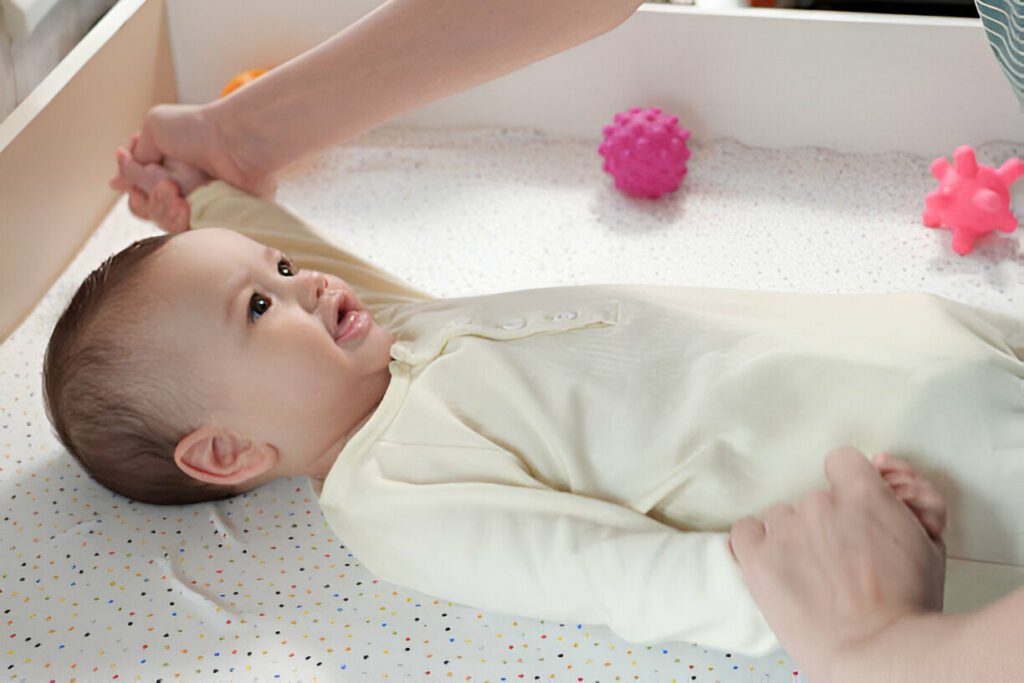When Do Babies Start Rolling Over? Your Complete Guide

Rolling over is one of the most exciting early milestones for both babies and parents. This physical achievement marks a significant step in your baby’s development, signaling growing strength and coordination. But when exactly do babies start rolling over, and what can you do to support this milestone?
Most babies begin rolling over between 4 and 7 months of age, though some may show early signs around 3 months. This milestone typically starts with rolling from tummy to back, followed by back to tummy rolling a few weeks later. Understanding what to expect can help you support your baby’s development while keeping them safe during this exciting phase.
Typical Age Range for Rolling Over
The journey of rolling over unfolds gradually, with most babies reaching this milestone within a predictable timeframe. Rolling over usually occurs between 4 and 7 months of age, though every baby develops at their own unique pace.
Some babies may show early signs of rolling around 3 months, while others might not master this skill until closer to 7 months. This variation is completely normal and reflects the individual nature of infant development.
Here’s what you can typically expect:
- 4-5 months: Many babies start rolling from tummy to back
- 5-7 months: Rolling from back to tummy often develops
- By 7 months: Most babies can roll confidently in both directions
Remember, these are general guidelines. Some babies might reach these milestones earlier or later, and both scenarios are usually perfectly normal.
Signs Your Baby Is Ready to Roll

Before your baby successfully rolls over, they’ll likely show several preparatory signs. These indicators suggest that your little one is building the necessary strength and coordination for this important milestone.
Watch for these key signs of readiness:
Stronger neck and arm muscles: Your baby will start using their arms to lift their chest higher during tummy time, demonstrating improved upper body strength.
Increased tummy time tolerance: Babies who are getting ready to roll often spend more time comfortably on their stomachs, pushing up and looking around.
Rocking movements: You might notice your baby rocking back and forth while on their tummy, as if they’re trying to figure out how to shift their weight.
“Swimming” motions: During tummy time, your baby may lift their arms and legs simultaneously while keeping their belly on the ground, resembling swimming movements.
Leg kicking and twisting: Strong leg movements and attempts to twist the lower body often precede successful rolling.
Rolling onto their side: This partial roll is often the first step toward a complete roll over.
Rolling from Tummy to Back: The First Success

Rolling from tummy to back is typically your baby’s first rolling achievement, and there’s a good reason why this happens first. This direction of rolling is easier because it requires less complex coordination and takes advantage of gravity.
Why tummy-to-back rolling comes first:
The mechanics of rolling from tummy to back are relatively simple. When your baby pushes up with their arms during tummy time, they’re already partway to completing the roll. A small shift in weight distribution can tip them over onto their back, often surprising both baby and parent the first time it happens.
What to expect:
Your baby might seem startled or even upset the first few times they roll from tummy to back. This reaction is completely normal since they weren’t expecting the sudden change in position. With practice, they’ll become more comfortable with the movement and may even start to enjoy this new ability.
Rolling from Back to Tummy: The More Complex Movement

Rolling from back to tummy typically develops after tummy-to-back rolling because it requires more sophisticated muscle coordination and strength. This movement involves multiple muscle groups working together in a complex sequence.
Why back-to-tummy rolling is more challenging:
When babies are on their backs, they can’t use their arms to push up and initiate the roll. Instead, they must coordinate their core muscles, neck strength, and leg movements to generate enough momentum to flip over. This requires greater muscle development and motor planning skills.
The development process:

Before successfully rolling from back to tummy, you might notice your baby:
- Tucking their chin toward their chest
- Pulling their legs up toward their body
- Rocking from side to side
- Lifting their head and shoulders off the ground
These movements are all building blocks for the eventual complete roll.
How to Encourage Your Baby’s Rolling Development
While your baby will naturally develop rolling skills as they grow stronger, there are several ways you can support and encourage this important milestone.
Prioritize tummy time:
Tummy time is the most important activity for developing rolling skills. This supervised play helps strengthen your baby’s neck, shoulders, arms, and core muscles. Start with short sessions of 3-5 minutes, two to three times daily, gradually increasing as your baby becomes more comfortable.
Make tummy time engaging:
- Place colorful toys or a mirror in front of your baby during tummy time
- Get down on the floor at your baby’s level to provide encouragement
- Use different textures and surfaces to keep tummy time interesting
- Try tummy time on your chest for bonding and comfort
Encourage reaching and stretching:
Place toys slightly out of reach to motivate your baby to stretch and reach across their body. This cross-body movement helps develop the coordination needed for rolling.
Support kicking play:
When your baby is on their back, encourage leg kicking by placing toys near their feet. Strong leg muscles contribute to the momentum needed for rolling over.
Be patient and supportive:
Avoid physically helping your baby roll over, as they need to develop the strength and coordination independently. Instead, offer encouragement and celebrate their efforts.
Essential Safety Measures
As your baby develops rolling skills, implementing proper safety measures becomes crucial to prevent accidents and ensure their wellbeing.
Never leave your baby unattended on elevated surfaces:
Even before your baby can roll consistently, they may surprise you with a sudden movement. Always keep a hand on your baby when they’re on changing tables, beds, or other high surfaces.
Create a safe play environment:
- Use a firm, flat surface for tummy time and play
- Remove small objects that could pose choking hazards
- Ensure the area is free from sharp edges or dangerous items
- Consider using a large blanket or play mat to define the safe play space
Adjust sleep safety practices:
Once your baby shows signs of rolling, it’s time to stop swaddling immediately. Swaddling can become dangerous when a baby can roll but cannot free their arms. Transition to a sleep sack or lightweight blanket instead.
Crib safety considerations:
- Ensure your baby’s crib meets current safety standards
- Remove any loose bedding, pillows, or stuffed animals
- Continue placing your baby on their back for sleep, even if they roll over during the night
- Once your baby can roll both ways confidently, it’s safe to let them find their own comfortable sleep position
When to Consult Your Pediatrician
While babies develop at different rates, there are certain timeframes when you might want to discuss your baby’s rolling progress with their healthcare provider.
Consider consulting your pediatrician if:
- Your baby isn’t showing signs of rolling by 6 months
- Your baby seems to have lost a rolling ability they previously had
- You notice significant weakness on one side of their body
- Your baby appears to avoid tummy time completely and shows no interest in lifting their head
- You have concerns about your baby’s overall muscle tone or development
What your pediatrician might assess:
During a consultation, your pediatrician will likely evaluate your baby’s overall muscle strength, coordination, and developmental progress. They may recommend physical therapy or additional exercises to support your baby’s development if needed.
Remember the bigger picture:
Rolling is just one of many developmental milestones. Your pediatrician will consider your baby’s overall growth and development pattern, not just their rolling abilities, when assessing their progress.
Supporting Your Baby’s Unique Journey

Every baby’s path to rolling over is different, and that’s perfectly normal. Some babies are enthusiastic rollers who use this skill to move around, while others might roll occasionally but prefer other ways of exploring their world.
Trust your baby’s timeline:
Some babies focus intensely on one skill before moving to another, while others develop multiple abilities simultaneously. Your baby might be working hard on social skills, language development, or fine motor skills while taking their time with rolling.
Celebrate small victories:
Each sign of progress, from stronger head control to increased tummy time tolerance, deserves celebration. These small steps are building blocks for the bigger milestone of rolling over.
Stay connected with your baby:
Pay attention to your baby’s cues and interests. If they seem frustrated during tummy time, try shorter sessions or different positions. If they’re enjoying movement games, incorporate more of these activities into your daily routine.
What Comes Next: Preparing for Future Milestones
Rolling over is an exciting milestone, but it’s also a stepping stone to other important developments. Understanding what typically comes next can help you prepare for your baby’s continued growth.
Upcoming milestones to anticipate:
- Sitting up independently (around 6-8 months)
- Crawling (typically 7-10 months)
- Pulling to stand (around 9-12 months)
- Taking first steps (usually 12-18 months)
How rolling supports future development:
The core strength, coordination, and spatial awareness your baby develops through rolling will serve them well as they progress to sitting, crawling, and eventually walking. Each milestone builds upon the previous ones, creating a foundation for lifelong physical development.
Your Baby’s Rolling Adventure Begins
Rolling over represents a significant leap in your baby’s physical development and independence. This milestone opens up new possibilities for exploration and play while strengthening the muscles and coordination needed for future achievements.
Remember that your baby’s development is unique, and comparing them to others isn’t helpful or necessary. Focus on providing plenty of opportunities for safe play, regular tummy time, and loving encouragement. Celebrate each small step along the way, and don’t hesitate to reach out to your pediatrician if you have concerns.
The journey of watching your baby grow and develop new skills is one of parenthood’s greatest joys. Rolling over is just the beginning of many exciting milestones ahead. Trust in your baby’s natural development timeline, stay engaged in their progress, and enjoy this special time of discovery together.






